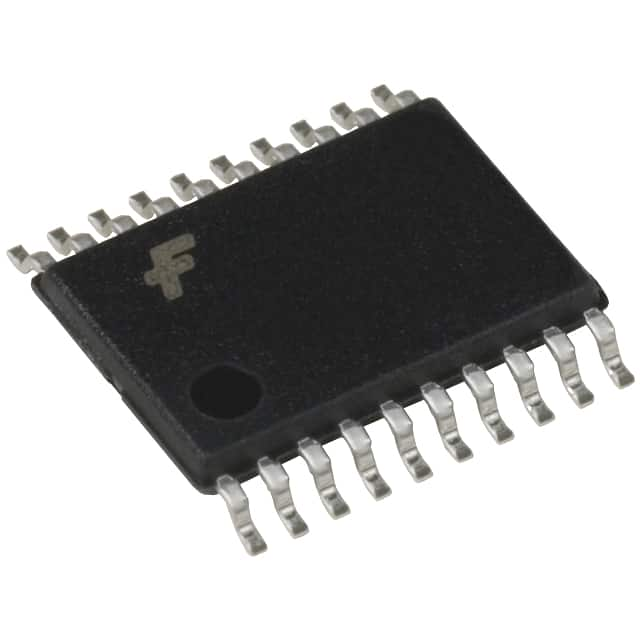Zie specificaties voor productdetails.

Encyclopedia Entry: 74ABT573CMTC
Product Overview
Category
The 74ABT573CMTC belongs to the category of integrated circuits (ICs) and specifically falls under the group of octal transparent latch with 3-state outputs.
Use
This product is commonly used in digital electronics for storing and transferring data. It provides a convenient way to control the flow of information within a circuit.
Characteristics
- Octal transparent latch with 3-state outputs
- High-speed operation
- Low power consumption
- Wide operating voltage range
- Schmitt-trigger action on all inputs
- Balanced propagation delays
- Symmetrical output impedance
Package
The 74ABT573CMTC is available in a small outline package (SO) with 20 pins. This package offers compactness and ease of integration into various electronic systems.
Essence
The essence of the 74ABT573CMTC lies in its ability to store and transfer data efficiently, enabling seamless communication between different components of a digital circuit.
Packaging/Quantity
This product is typically packaged in reels or tubes, containing a specific quantity of ICs per package. The exact packaging and quantity may vary depending on the manufacturer.
Specifications
- Supply Voltage Range: 4.5V to 5.5V
- Input Voltage Range: 0V to VCC
- Output Voltage Range: 0V to VCC
- Operating Temperature Range: -40°C to +85°C
- Maximum Clock Frequency: 125 MHz
- Output Drive Capability: ±24 mA
Detailed Pin Configuration
The 74ABT573CMTC has a total of 20 pins, each serving a specific function. Here is the detailed pin configuration:
- D0: Data input 0
- D1: Data input 1
- D2: Data input 2
- D3: Data input 3
- D4: Data input 4
- D5: Data input 5
- D6: Data input 6
- D7: Data input 7
- GND: Ground
- OE: Output enable
- LE: Latch enable
- Q0: Output 0
- Q1: Output 1
- Q2: Output 2
- Q3: Output 3
- Q4: Output 4
- Q5: Output 5
- Q6: Output 6
- Q7: Output 7
- VCC: Supply voltage
Functional Features
- Transparent latch operation: Allows data to pass through when the latch enable (LE) signal is high.
- 3-state outputs: Provides the ability to disconnect the outputs from the bus, allowing multiple devices to share the same bus without interference.
- Schmitt-trigger action: Ensures reliable and noise-immune operation by providing hysteresis on all inputs.
Advantages and Disadvantages
Advantages
- High-speed operation enables efficient data transfer.
- Low power consumption helps in reducing overall energy usage.
- Wide operating voltage range allows compatibility with various systems.
- Schmitt-trigger action ensures reliable operation even in the presence of noise.
- Balanced propagation delays ensure accurate timing.
Disadvantages
- Limited output drive capability may restrict its use in certain applications requiring higher current sourcing/sinking capabilities.
- The small outline package (SO) may limit heat dissipation in high-power applications.
Working Principles
The 74ABT573CMTC operates based on the principles of digital logic. When the latch enable (LE) signal is high, the data inputs (D0-D7) are transparently transferred to the outputs (Q0-Q7). The output enable (OE) signal controls whether the outputs are active or in a high-impedance state.
Detailed Application Field Plans
The 74ABT573CMTC finds applications in various digital systems, including but not limited to: - Microprocessors and microcontrollers - Data storage systems - Communication equipment - Industrial automation - Automotive electronics - Consumer electronics
Detailed and Complete Alternative Models
There are several alternative models available that offer similar functionality to the 74ABT573CMTC. Some notable alternatives include: - 74HC573: A CMOS-based octal latch with 3-state outputs. - SN74LS373: A TTL-based octal latch with 3-state outputs. - CD40107B: A CMOS-based dual 4-bit static shift register.
These alternative models can be considered based on specific requirements such as voltage levels, power consumption, speed, and package options.
Word Count: 552 words
Noem 10 veelgestelde vragen en antwoorden met betrekking tot de toepassing van 74ABT573CMTC in technische oplossingen
Sure! Here are 10 common questions and answers related to the application of 74ABT573CMTC in technical solutions:
Q: What is the 74ABT573CMTC? A: The 74ABT573CMTC is a octal transparent latch with 3-state outputs, commonly used in digital circuits.
Q: What is the purpose of the 74ABT573CMTC? A: The purpose of this component is to store and control the flow of data in a digital system.
Q: How many bits can the 74ABT573CMTC handle? A: It can handle 8 bits of data, as it is an octal latch.
Q: What does "transparent" mean in the context of the 74ABT573CMTC? A: "Transparent" means that the input data is directly transferred to the output when the latch is enabled.
Q: What are the 3-state outputs in the 74ABT573CMTC? A: The 3-state outputs allow the outputs to be in three different states: high, low, or high impedance (disconnected).
Q: How do I enable or disable the 74ABT573CMTC? A: The latch is enabled by applying a high signal to the enable pin (E). It is disabled by applying a low signal to the enable pin.
Q: Can I cascade multiple 74ABT573CMTC latches together? A: Yes, you can cascade multiple latches to increase the number of bits stored or controlled.
Q: What is the power supply voltage range for the 74ABT573CMTC? A: The typical power supply voltage range is between 4.5V and 5.5V.
Q: What is the maximum clock frequency supported by the 74ABT573CMTC? A: The maximum clock frequency is typically around 200 MHz, but it may vary depending on the specific conditions.
Q: Can I use the 74ABT573CMTC in both synchronous and asynchronous applications? A: Yes, the 74ABT573CMTC can be used in both synchronous and asynchronous applications, depending on the requirements of the system.
Please note that these answers are general and may vary depending on the specific datasheet and application guidelines provided by the manufacturer.

